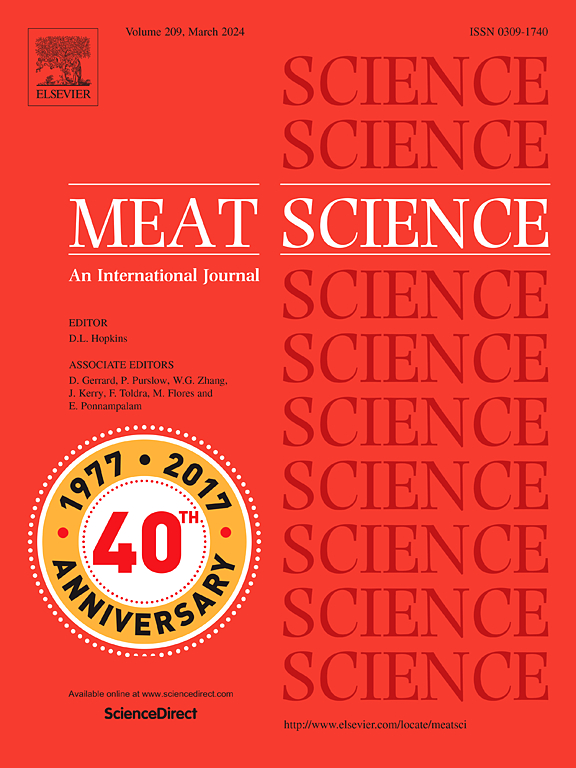How chloride salt mixtures affect the final gel properties of low-sodium myofibrillar protein: Underlining the perspective of gelation process
IF 7.1
1区 农林科学
Q1 Agricultural and Biological Sciences
引用次数: 0
Abstract
This study aimed to investigate the performance differences of low-sodium myofibrillar protein (MP) gels substituted by different chloride salt mixtures from the perspective of gelation process. The results revealed that low-sodium MP substituted by KCl/CaCl2 exhibited higher turbidity and particle size at 40 % substitution, and formed protein aggregates earlier at 53 °C. During the gelation process, KCl/CaCl2 increased the extent of cross-linking as the substitution level increased from 10 % to 40 %, which was prone to forming final gels with poor palatability. Microstructural and binarization results visually indicated that an irregular reticular structure composed of partial clusters formed when the temperature heated over 53 °C, and the cross-linked cluster blocks further shrunk from 53 °C to 73 °C. Rheological amplitude sweeps revealed that KCl/CaCl2-substitued MP displayed a faster fracture of the ductile structure, and this influenced the distribution of cluster blocks inside the network. The introduction of salt mixtures altered protein conformation, and more unordered structures were found in low-sodium MP containing CaCl2, rather than MP containing MgCl2. Additionally, Ca2+ ions increased the thermo-denatured temperature of MP, and extended the relaxation time of bound water at 53 °C, and Mg2+ ions slowed down the degree of liquid loss at 53 °C. As a result, the low-sodium MP containing CaCl2 exhibited a lower expansion of protein structure accompanied by the involvement of less proteins in gel formation and more liquid loss in the final gel.

氯盐混合物如何影响低钠肌原纤维蛋白的最终凝胶特性:强调凝胶化过程的观点。
本研究旨在从凝胶过程的角度研究不同氯盐混合物替代的低钠肌纤原蛋白(MP)凝胶的性能差异。结果表明,KCl/CaCl2取代的低钠MP在40%取代时表现出更高的浊度和粒径,并且在53°C时更早形成蛋白质聚集体。在胶凝过程中,KCl/CaCl2的交联程度随着取代量从10%增加到40%而增加,容易形成口感较差的终凝胶。显微组织和二值化结果直观地表明,当温度超过53℃时,形成了由部分团块组成的不规则网状结构,从53℃到73℃,交联的团块进一步缩小。流变振幅扫描显示,KCl/ cacl2取代的聚丙烯腈表现出更快的韧性结构断裂,这影响了网络内簇块的分布。盐混合物的引入改变了蛋白质的构象,并且在含有CaCl2的低钠MP中发现了更多的无序结构,而不是含有MgCl2的MP。Ca2+离子提高了MP的热变性温度,延长了结合水在53℃时的弛豫时间,Mg2+离子减缓了53℃时的失液程度。结果,含有CaCl2的低钠MP表现出较低的蛋白质结构扩张,同时在凝胶形成中参与较少的蛋白质和最终凝胶中更多的液体损失。
本文章由计算机程序翻译,如有差异,请以英文原文为准。
求助全文
约1分钟内获得全文
求助全文
来源期刊

Meat Science
工程技术-食品科技
CiteScore
12.60
自引率
9.90%
发文量
282
审稿时长
60 days
期刊介绍:
The aim of Meat Science is to serve as a suitable platform for the dissemination of interdisciplinary and international knowledge on all factors influencing the properties of meat. While the journal primarily focuses on the flesh of mammals, contributions related to poultry will be considered if they enhance the overall understanding of the relationship between muscle nature and meat quality post mortem. Additionally, papers on large birds (e.g., emus, ostriches) as well as wild-captured mammals and crocodiles will be welcomed.
文献相关原料
公司名称
产品信息
阿拉丁
NaCl
阿拉丁
KCl
阿拉丁
MgCl2
阿拉丁
CaCl2
阿拉丁
NaCl
阿拉丁
KCl
阿拉丁
MgCl2
阿拉丁
CaCl2
 求助内容:
求助内容: 应助结果提醒方式:
应助结果提醒方式:


